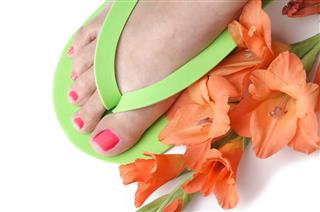
Though they seem comfortable, you may be surprised to learn that flip-flops are bad for your feet. We tell you more about the harmful effects of wearing flip-flops frequently.
Did You Know?
Flip-flops without an arch can make you flat-footed (even if you aren’t), because with no arch support your feet may start turning inward.
The easy-breezy look, bright colors, unique patterns, and comfortable feel that flip-flops offer are generally too appealing to resist. Hence, they secure a significant place in shoe closets and are considered best companions, especially when summer rolls around. The feeling of wearing a comfortable pair of flip-flops, and taking a long walk along the seashore, feeling the breeze on a hot sunny day can indeed be a relaxing activity, to say the least. Most people go further than that, and use flip-flops as regular footwear in the summer, thanks to the comfort they offer.
However, in spite of the comfort they offer, regular use of flip-flops is not a good idea, as they may take a toll on your feet as well as overall health. Several researches have been carried out in this field to evaluate the benefits and risks of wearing flip-flops, and unfortunately, the risks outweigh the benefits associated with their use. Surprised? Don’t be. The adverse effects of wearing flip-flops has been discussed in the following section.
Constant Use of Flip-flops Can Harm Your…
… Toes
The toe area is one of the areas where flip-flops cause severe problems. If you try to observe your feet while walking in flip-flops, you will feel a prominent clenching of your toes while lifting your foot and stepping forward. This is because your toes try to grip the footwear in order to prevent it from slipping off your feet. Repeated clenching leads to an abnormal bending of the toes, which may be hard to repair. Clenching also puts excessive pressure on the toes, causing tenderness and even throbbing pain.
… Arch
Apart from the toes, this is another foot area that can be severely affected by constant use of flip-flops. The arch of the foot is created by plantar fascia (a thick band of tissue) that runs from the heel to the ball of the foot. Lack of support to the arch leads to inflammation of the plantar, which, in turn, causes plantar fasciitis. It is a severe foot condition that causes arch pain, which may aggravate with repetitive use of flip-flops. The lack of support can also make the arch flatten out, resulting in flat feet.
… Heels
Amongst all, the heel can be considered the most adversely affected area due to frequent use of flip-flops, the reason being the constant rising movement of the heel from the base of the footwear while walking. As it is with the arch, the heel is also prone to plantar fasciitis. A dull or sharp pain in the heel is a good indicator of plantar fascitiis, and if you are experiencing such pain because of wearing flip-flops, stop using them and contact your health care provider right away.
… Ankles
Due to the lack of proper support around the ankles, twists and sprains may occur very easily if flip-flops are worn on a regular basis. Moreover, the way you carry your feet in flip-flops is totally different from the way you do it in a more supportive shoe. This alters the entire way of walking, in the sense that you tend to take shorter steps in flip-flops and cause inward turning of the ankles. It further alters your natural gait while making you prone to several ankle and hip problems.
… Foot Pad
Normally, we use footwear to offer comfort to our feet and protect them from various hazardous objects lying on the ground. However, when it comes to flip-flops, the base of the footwear is itself the cause of discomfort and injuries.
Unlike other supportive shoes, flip-flops cause your feet to make more movements. Movement causes friction, and hence, when there is constant rubbing between the sole or pad of the foot and the base of the flip-flops, it creates a burning sensation or cause blisters on the foot pad. The condition of the foot may worsen if the friction is accompanied by sweat and body heat.
After going through the negatives of wearing flip-flops, if you still can’t give up on them, here are a few tips about how to choose the correct ones, minimize their use, and when to replace them:
Look for Correct Size
Well, this applies to all types of footwear. Your flip-flops should neither be too small nor too big for your feet; just the perfect size. While oversized flip-flops might cause you to slip off a surface, smaller ones may invite pebbles, nails, and other sharp objects lying on the ground to hurt your heel or toe.
Avoid Wearing Them in Wrong Locations
As mentioned earlier, long walks are not your flip-flops’ cup of tea. They are meant only for the beach and poolside strides, or light walking around the house. Ensure not to wear flip-flops while trekking, playing sports, or gardening.
Replace Them Regularly
Worn out flip-flops are even more dangerous for your feet. Look for cracks in the soles, foot indentations on the upper side, or the post getting loose before you slip into your flip-flops. If you find any of these signs, go shopping for a new pair.
By wearing flip-flops occasionally, you can enjoy their comfortable feel, and at the same time, avoid severe foot problems which may be caused by their constant use.












